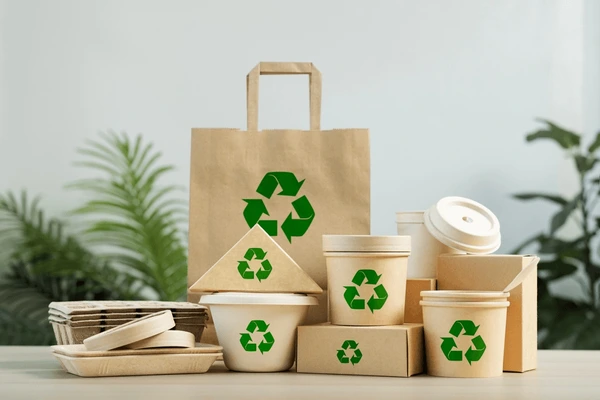One of the biggest environmental issues we face today is plastic pollution. Millions of tons of plastic waste end up in landfills and oceans every year. This makes it more important than ever to find eco-friendly alternatives. While plastic is convenient, durable, and cheap, it has a huge impact on the environment in the long run. It takes hundreds of years to break down, which not only increases greenhouse gas emissions but is also harmful to animals. This is where technology comes in: new, sustainable materials that can replace plastic without losing their functionality.
The Tech World is Witnessing the Rise of Bioplastics
Bioplastics are gaining popularity as an eco-friendly alternative to regular plastics. Bioplastics are made from renewable resources such as cornstarch, sugarcane, and potato starch, while regular plastics are made from petroleum. Under the right conditions, these materials can be broken down and used as compost. Companies in the electronics industry are using bioplastics to produce phone cases, packaging, and even printed circuit boards. The tech industry can reduce its carbon footprint by using bioplastics without sacrificing product quality and longevity.
Packaging Solutions for Mushrooms
One of the most creative plastic alternatives is mushrooms, and they come from an unexpected source. The root structure of mushrooms, called mycelium, can grow and form into different shapes and sizes. This material is lightweight, strong, and biodegradable, making it an excellent alternative to plastic packaging. New and existing IT companies are starting to use mycelium-based packaging to safely ship electronic devices. This not only reduces plastic waste but also encourages the use of naturally occurring and renewable materials.
Plant-based Polymers for Electronics
Plant-based polymers are another promising way to reduce plastic use in the tech sector. These materials are made from cellulose, which is found in the cell walls of plants. Plant-based polymers can be used to create durable yet flexible components for phones, computers, and other electronics. These polymers are great because they have the same physical properties as plastics, but with greater environmental benefits. Technology companies are increasingly using plant-based materials in their product designs to meet the needs of environmentally conscious consumers.
Make Electronics from Recycled Materials
Recycling is an important part of reducing plastic pollution, and many technology companies are making products from recycled materials. You can recycle old plastic bottles, fishing nets, and broken electronics to make new electronics or parts. For example, some laptop manufacturers are now selling laptop parts made from recycled metals and plastics. This approach not only reduces the demand for new plastics but also helps us better manage existing plastic waste. This is an important step towards a circular economy in the technology world.
Silicone is a Safer and More Sustainable Alternative
Silicone is often considered safer and more environmentally friendly than plastic, especially when it comes to tech accessories like phone cases, keyboard covers, and wearable wristbands. Unlike plastic, silicone is heat-resistant, flexible, and durable. It does not break down into small plastic fragments and can be recycled at designated locations. Silicone is not fully biodegradable, but it is more environmentally friendly than regular plastic, especially for products that need to be reused.
Edible and Water-soluble Packaging Films
Edible and water-soluble films are another tech-friendly plastic option that has been gaining a lot of attention. These films are made from natural substances such as seaweed and rice starch. They are used to package devices and accessories. Although they are still emerging materials, they can help reduce the use of single-use plastics in packaging. They can be composted or soaked in water, and they do not leave behind any hazardous chemicals. This is especially useful in the e-commerce sector, where eco-friendly packaging can reduce a lot of waste.
Algae-Based Plastics in Tech Accessories
Algae polymers are emerging as a new eco-friendly option for many technology applications. Algae grows quickly, requires few resources, and is easy to collect without harming the environment. Algae can be converted into bioplastics, which can be used in products such as USB cases, phone holders, and headphones. These products not only look great but also break down naturally, which is a smart way to tackle the growing plastic problem in consumer electronics.
Paper and Cardboard Innovations in Tech Packaging
Paper and cardboard have been used for packaging for decades, but recent advances have made them stronger, more flexible, and more suitable for technology applications. New ideas such as pulp molding and corrugated cardboard design now allow companies to ship fragile devices without using plastic materials such as bubble wrap or polystyrene. Paper and cardboard are also easy to recycle and break down, making them ideal for eco-friendly packaging.
How Does 3D Printing Reduce Plastic Waste?
3D printing makes the manufacturing process more efficient and can be tailored to the needs of the customer, reducing material waste. When using biodegradable or recyclable materials, 3D printing is a powerful weapon in the fight against plastic pollution. Tech companies are exploring 3D printing with eco-friendly filaments made from PLA (polylactic acid), recycled plastics, and even wood composites. This method can be produced on demand and has a lower environmental impact than traditional manufacturing methods.
Consumer Awareness
Ultimately, tech-friendly plastic alternatives will only work if people understand and want to use them. As people become more aware of the impact of their purchases on the environment, they are also starting to look for products that are produced and packaged in an environmentally friendly way. As demand for these products continues to grow, tech companies are also paying more attention to producing products and sourcing materials in an environmentally friendly way. By educating people about the benefits of plastic alternatives, the tech sector will accelerate the transition to a greener, more sustainable future.
Conclusion
As technology advances, so does our ability to apply new ideas to solve environmental problems. People are looking for ways to replace plastic with new and exciting materials, such as bioplastics, mycelium, plant-based polymers, and algae plastics. These tech-friendly options not only allow us to reduce our dependence on fossil fuels but also help reduce plastic waste. From packaging to product components, these materials can help us transition to a more sustainable future in many ways. While barriers still exist, the growing support from consumers, governments, and the IT industry shows that people are moving in a positive direction and choosing more environmentally friendly choices. Using these materials is more than just a trend; it is a necessity to protect the planet for future generations.
FAQs
1. What does bioplastic look like?
Bioplastics are made from renewable resources, such as cornstarch, sugarcane, or potato starch. They can be broken down or composted.
2. Are these plastic alternatives as strong as regular plastics?
Plant-based polymers and silicone are just two alternatives that are just as strong and durable as regular plastics.
3. Is silicone better than plastic?
Many electronic products are made with silicone instead of plastic, which is better for the environment. Silicone is heat-resistant, reusable, and lasts longer.
4. Can materials made from mushrooms really replace plastic?
Yes, mycelium packaging is lightweight, durable, and biodegradable, making it an ideal alternative to plastic packaging.
5. How can people help plastic alternatives?
People can promote eco-friendly products by choosing smart devices and packaging made from eco-friendly materials and encouraging companies to take more environmental measures.




